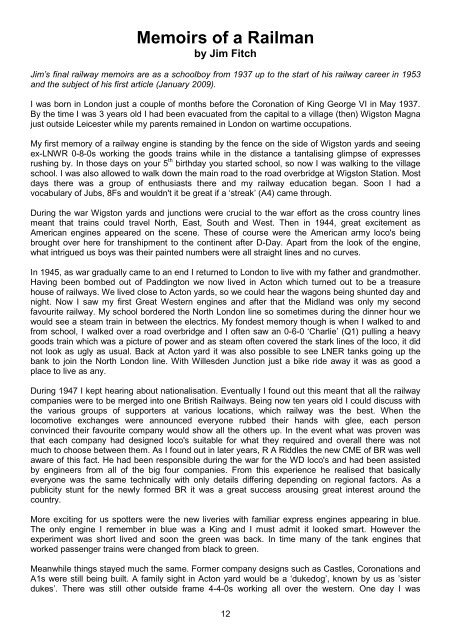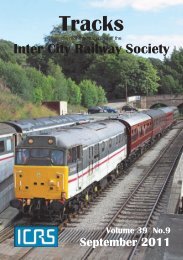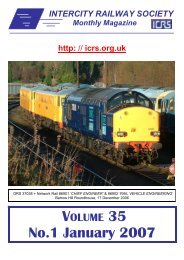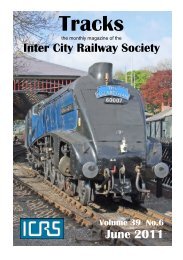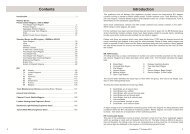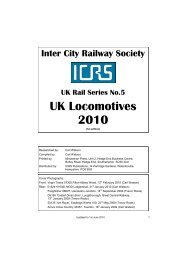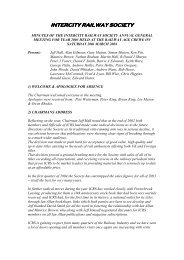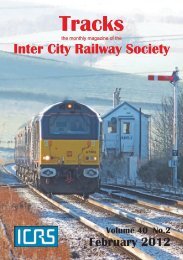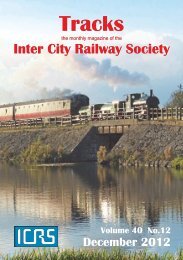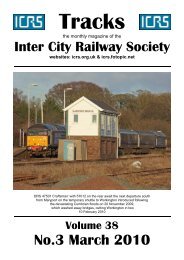April - Intercity Railway Society
April - Intercity Railway Society
April - Intercity Railway Society
You also want an ePaper? Increase the reach of your titles
YUMPU automatically turns print PDFs into web optimized ePapers that Google loves.
Memoirs of a Railman<br />
by Jim Fitch<br />
Jim’s final railway memoirs are as a schoolboy from 1937 up to the start of his railway career in 1953<br />
and the subject of his first article (January 2009).<br />
I was born in London just a couple of months before the Coronation of King George VI in May 1937.<br />
By the time I was 3 years old I had been evacuated from the capital to a village (then) Wigston Magna<br />
just outside Leicester while my parents remained in London on wartime occupations.<br />
My first memory of a railway engine is standing by the fence on the side of Wigston yards and seeing<br />
ex-LNWR 0-8-0s working the goods trains while in the distance a tantalising glimpse of expresses<br />
rushing by. In those days on your 5 th birthday you started school, so now I was walking to the village<br />
school. I was also allowed to walk down the main road to the road overbridge at Wigston Station. Most<br />
days there was a group of enthusiasts there and my railway education began. Soon I had a<br />
vocabulary of Jubs, 8Fs and wouldn't it be great if a ‘streak’ (A4) came through.<br />
During the war Wigston yards and junctions were crucial to the war effort as the cross country lines<br />
meant that trains could travel North, East, South and West. Then in 1944, great excitement as<br />
American engines appeared on the scene. These of course were the American army loco's being<br />
brought over here for transhipment to the continent after D-Day. Apart from the look of the engine,<br />
what intrigued us boys was their painted numbers were all straight lines and no curves.<br />
In 1945, as war gradually came to an end I returned to London to live with my father and grandmother.<br />
Having been bombed out of Paddington we now lived in Acton which turned out to be a treasure<br />
house of railways. We lived close to Acton yards, so we could hear the wagons being shunted day and<br />
night. Now I saw my first Great Western engines and after that the Midland was only my second<br />
favourite railway. My school bordered the North London line so sometimes during the dinner hour we<br />
would see a steam train in between the electrics. My fondest memory though is when I walked to and<br />
from school, I walked over a road overbridge and I often saw an 0-6-0 ‘Charlie’ (Q1) pulling a heavy<br />
goods train which was a picture of power and as steam often covered the stark lines of the loco, it did<br />
not look as ugly as usual. Back at Acton yard it was also possible to see LNER tanks going up the<br />
bank to join the North London line. With Willesden Junction just a bike ride away it was as good a<br />
place to live as any.<br />
During 1947 I kept hearing about nationalisation. Eventually I found out this meant that all the railway<br />
companies were to be merged into one British <strong>Railway</strong>s. Being now ten years old I could discuss with<br />
the various groups of supporters at various locations, which railway was the best. When the<br />
locomotive exchanges were announced everyone rubbed their hands with glee, each person<br />
convinced their favourite company would show all the others up. In the event what was proven was<br />
that each company had designed loco's suitable for what they required and overall there was not<br />
much to choose between them. As I found out in later years, R A Riddles the new CME of BR was well<br />
aware of this fact. He had been responsible during the war for the WD loco's and had been assisted<br />
by engineers from all of the big four companies. From this experience he realised that basically<br />
everyone was the same technically with only details differing depending on regional factors. As a<br />
publicity stunt for the newly formed BR it was a great success arousing great interest around the<br />
country.<br />
More exciting for us spotters were the new liveries with familiar express engines appearing in blue.<br />
The only engine I remember in blue was a King and I must admit it looked smart. However the<br />
experiment was short lived and soon the green was back. In time many of the tank engines that<br />
worked passenger trains were changed from black to green.<br />
Meanwhile things stayed much the same. Former company designs such as Castles, Coronations and<br />
A1s were still being built. A family sight in Acton yard would be a ‘dukedog’, known by us as ’sister<br />
dukes’. There was still other outside frame 4-4-0s working all over the western. One day I was<br />
12


